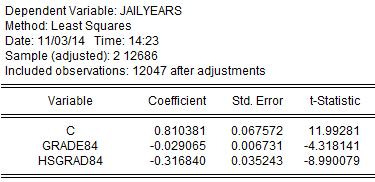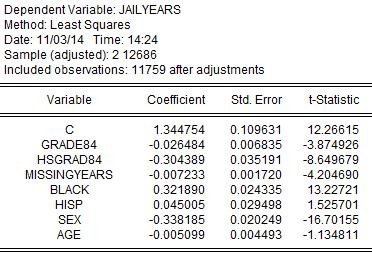Crime, Education, and the NLSY: The Role of the Sheepskin Effect
Most of the payoff from education comes from credentials, not mere years of class time, a regularity known as the sheepskin effect. A quick look at crime as a function of education suggests a strong sheepskin effect for crime as well.
Are appearances revealing? I decided to see for myself in the NLSY. For convenience, I only look at the discrete effect of high school graduation, and equate “high school graduate” with “finished 12th grade.” My measure of crime continues to be the total number of times the respondent was interviewed in jail.
Baseline results confirm a massive sheepskin effect:

For a four-year high school degree, this implies that the last year of high school provides 80% of the crime reduction effect. How robust is this result? Controlling for demographics and missing residential information makes little difference.

After adjusting for measured intelligence, however, virtually nothing is left except the sheepskin effect!

After adjusting for attitudes and teen behavior, continuous years of education actually seem to slightly increase incarceration:

Of course, the criminogenic effect of years of education is neither statistically significant nor plausible. What happens if we simply discard years of education as a control variable? Then the baseline regression becomes:

With all the control variables, this morphs into:

Punchline: All of the effect of education on incarceration looks like a sheepskin effect, but about 40% of that sheepskin effect goes away after taking intelligence, attitudes, and risky teen behavior into account.
If, like me, you view sheepskin effects as a strong symptom of signaling, this means that the selfish and social effects of education on crime sharply diverge. Getting your kid to finish high school genuinely reduces his expected jail time, albeit by markedly less than meets the eye. Socially speaking, however, trying to fight crime by getting everyone to finish high school is futile. The more degrees people have, the more degrees people need to get a good job. So regardless of the average education level, you should expect many young men at the bottom of the educational pecking order to continue to opt for crime over honest toil.
P.S. If worker quality exogenously increases, as I’ve explained before, we should expect education to go up and crime to go down. Rising education – even rising useless education – can be a symptom of social progress. But that doesn’t mean that rising education is progress.
The post appeared first on Econlib.


